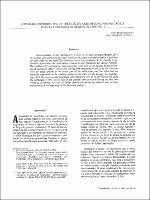| dc.contributor.author | Marchezan, E | |
| dc.contributor.author | Costa, J.A. | |
| dc.date.accessioned | 2022-09-07T15:49:12Z | |
| dc.date.available | 2022-09-07T15:49:12Z | |
| dc.date.issued | 1983-01 | |
| dc.identifier.uri | https://repositorio.catie.ac.cr/handle/11554/11975 | |
| dc.description.abstract | Caracterization of the reproductive activity of soybean cultivars Planalto, Br-4 and Salina, was performed by node, both for the main stein and branches. Condition for high yield was provided. This field experiment was conducted at the Estacilo Experimental Agronomica da Universidade Federal do Rio Grande do Sul, during 1980181. The medium part contributed, approximately, with 50% of the flowers and pods pro-duced and fired. About 50% of the reproductive structures produced by the branches were on those located at the lower part of the twin stem, and the other half on branches originated on the medium section of the plant. On the average, the time during which the reproductive structures were produced was of 53 days (from R1 until the beginning of R6) About 50% of the flowers were produced during the first two weeks of flowering. The rate of flower production picked up between days seventh and tenth after the beginning of the flowering period. | es_ES |
| dc.description.abstract | La caracterización de la actividad reproductiva de los cultivares de soja Planalto, Br-4 y Salina, se realizó por nódulos, tanto para el novillo principal como para las ramas. Se proporcionó la condición de alto rendimiento. Este experimento de campo fue realizado en el Estacilo Experimental Agronómico de la Universidad Federal de Rio Grande do Sul, durante 1980181. La parte media contribuyó, aproximadamente, con el 50% de las flores y vainas producidas y disparadas. Aproximadamente el 50% de las estructuras reproductivas producidas por las ramas fueron en las ubicadas en la parte inferior del tallo gemelo, y la otra mitad en las ramas originadas en la parte media de la planta. En promedio, el tiempo durante el cual se produjeron las estructuras reproductivas fue de 53 días (desde R1 hasta el comienzo de R6). Alrededor del 50% de las flores se produjeron durante las dos primeras semanas de floración. La tasa de producción de flores aumentó entre los días séptimo y décimo después del inicio del periodo de floración. | es_ES |
| dc.format.extent | 6 páginas | es_ES |
| dc.language.iso | pt | es_ES |
| dc.publisher | Instituto Interamericano de Cooperación para la Agricultura (IICA) | es_ES |
| dc.relation.ispartof | Turrialba; Vol. 33, no. 1 | es_ES |
| dc.subject | VARIEDADES | es_ES |
| dc.subject | GLYCINE MAX | es_ES |
| dc.subject | PROPAGACION VEGETATIVA | es_ES |
| dc.subject | DESARROLLO BIOLOGICO | es_ES |
| dc.subject | GENOTIPOS | es_ES |
| dc.subject | FLORACION | es_ES |
| dc.subject | BRASIL | es_ES |
| dc.subject | VARIETIES | es_ES |
| dc.subject | GLYCINE MAX | es_ES |
| dc.subject | VEGETATIVE PROPAGATION | es_ES |
| dc.subject | BIOLOGICAL DEVELOPMENT | es_ES |
| dc.subject | FLOWERING | es_ES |
| dc.subject | BRAZIL | es_ES |
| dc.subject.other | Sede Central | es_ES |
| dc.title | Actividad reproductiva de tres cultivares de soya, por sección de la planta y estadios de desarrollo | es_ES |
| dc.title.alternative | Reproductive activity of three soybean cultivars by plant section and development stage | es_ES |
| dc.title.alternative | Atividade reprodutiva de tres cultivares de soja, por seccao da planta e estádios de desenvolvimento. | es_ES |
| dc.type | Artículo | es_ES |
| dc.identifier.status | openAccess | es_ES |


